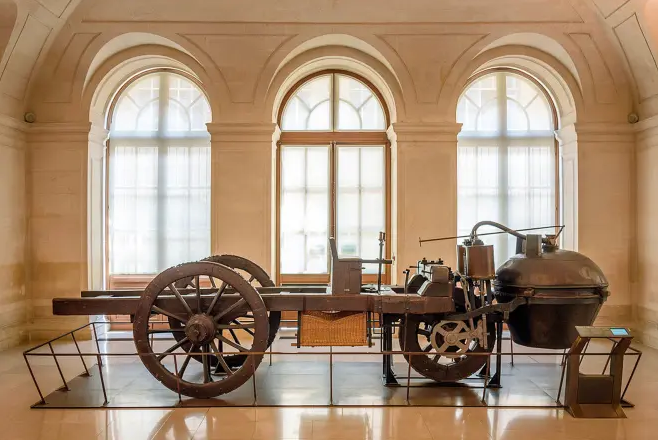Comedian and auto enthusiast Jay Leno recently made headlines after receiving some fairly serious burns while getting ready to tool around in one of his vintage steam powered cars.
The accident shows, yet again, that steam-powered automobiles were never a good idea.
To be fair to Leno, he has always displayed almost maniacal attention to safety when it comes to all of his rides, and especially the vintage models he collects. Many of his cars have hidden safety retrofits, and he is known to keep a fire extinguisher in all his cars.
However, no retrofit can make a steam car entirely safe.
It is rather interesting that the website Wikipedia salivates over the steam car as being “safe, reliable and almost emission-free.” None of those things are true, and that is why real researchers never cite Wikipedia.

The steam l-powered car can be credited with putting humanity on the road long before the internal combustion engine was invented. According to Frank Filipponio, writing for AutoBlog, a Frenchman by the name of Nicholas Joseph Cugnot in 1769 created a behemoth three-wheeled contraption that looked like it was being towed by a giant egg that emitted steam.
The machine was so slow that it might have been rated in negative horsepower.
MORE: MotorHeadline: Toyota’s EV strategy has changed for the better
In the early 1900s, the gasoline automobile had as many drawbacks as it did advantages. Gas-powered cars were smelly, loud and took a strong man with a strong arm to crank, which spurred companies such as Stanley, White and Oldsmobile to look at steam as an alternative. After all, steam powered locomotives and ocean liners, why not have it power cars?
The culture of the time must also be considered when delving into the reasons engineers attempted to craft such intricate machinery when a few pistons and a drivetrain would have sufficed.
The Edwardian Era, or Gilded Age, was one of constant luxury and decorum for those who could afford it.
The film “Titanic” perfectly displays the social mores of a time when people wished to cross the Atlantic without ever knowing they were on a ship. Money was no object when it came to comfort and style.
Therefore, sitting in the back of a car with a roaring engine that belched out black smoke was simply not a genteel way to get around as the noise stifled polite conversation.
Enter the steam car, which made no noise at all and mainly only emitted excess steam. The fact that an owner not only needed a driver, but a driver who was a trained steam car mechanic, did not bother the Edwardians a bit. One could enjoy a conversation and a brandy while traveling and leave the driving up to the professional.
In one of his many videos, Leno shows how to get a 1909 White Model M ready for the road. In the video, he cheekily warns of the dangers.
“I suppose you could get scalded to death or burned to death, but when this thing gets running, it’s worth it,” Leno said.
Getting a steam car running was an exhaustive and time consuming task. Each valve and dial indicator had to be checked constantly and there were indicators for fire, pressure, water levels, pilot and the list goes on and on.
MORE: MotorHeadline: The boozy beginnings of NASCAR
Most steam cars had a 15- or so gallon water tank and others, such as Leno’s White Model M, used a coil system that cut the prep time from about 45 minutes to around 20 minutes. In the 1980’s, car owners steered away from the Oldsmobile diesels because it took five minutes for the glow plugs to warm up in cold weather, imagine waiting a half hour or longer to get going!
Steam cars took two types of gasoline, one to light the pilot and another fuel to boil the water and create steam. Since the flame was on the outside of the engine, anything combustible near it could go up in flames. Meanwhile, misjudging the water level could lead to a boiler explosion.
Over time, the steam car was refined, according to Smithsonian Magazine, and the 1917 Doble Detroit prototype sported only reverse and brake pedals along with a hand throttle. The instrument cluster no longer took over the entire length of the dashboard, but it was too late.
The decline of the steam car began in 1924 with the foundering of Doble, and by 1939 there were virtually none left on the roadways, according to Smithsonian.
Automakers have looked for alternatives to the standard gasoline power for automobiles long before air pollution became more than just a mild irritant. Engineers have toyed with magnetos, created turbines that run on perfume or vodka and even hypothesized that a tiny nuclear power plant under the hood might be the propulsion method of the future.
No thanks, I’ll just stick to what is tried and true, be it gas or electric. The thought of driving around in a nuclear reactor is just a little too much, but I can hear old Jay saying, “Yeah, sure you might get fried to a crisp or suffer radiation burns, but once you get this thing running….”
Here’s to Jay Leno’s continued healing and recovery.
See you on the road!!
Scott Hudson is the senior reporter for The Augusta Press. Reach him at scott@theaugustapress.com












